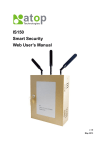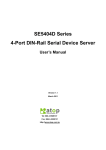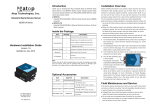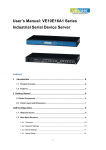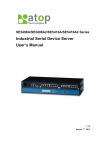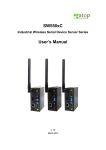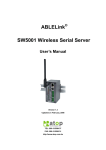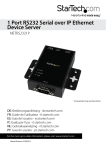Download SE5001A Serial Device Server
Transcript
SE5001A Serial Device Server User’s Manual v. 1.0 August 2012 Important Announcement The information contained in this document is the property of Atop Technologies, Inc. and is supplied for the sole purpose of operation and maintenance of Atop Technologies, Inc. products. No part of this publication is to be used for any other purposes, and it is not to be reproduced, copied, disclosed, transmitted, stored in a retrieval system, or translated into any human or computer language, in any form, by any means, in whole or in part, without the prior explicit written consent of Atop Technologies, Inc., offenders will be liable for damages. All rights, including rights created by patent grant or registration of a utility model or design, are reserved. Disclaimer We have checked the contents of this manual for agreement with the hardware and software described. Since deviations cannot be precluded entirely, we cannot guarantee full agreement. However, the data in this manual is reviewed regularly and any necessary corrections included in subsequent editions. Suggestions for improvement are welcome. All other product names referenced herein are registered trademarks of their respective companies. Published by Atop Technologies, Inc. 2F, No. 146, Sec. 1, Tung-Hsing Rd. Jubei, Hsinchu 30261 Taiwan, R.O.C. Tel: 886-3-5508137 Fax: 886-3-5508131 www.atop-tech.com www.atop.com.tw Copyright © 2011 Atop Technologies, Inc. All rights reserved. Technical data is subject to change. All other product names referenced herein are registered trademarks of their respective companies. This document is intended to provide customers with brief descriptions on the product and to assist customers to get started. For detail information and operations of the product, please refer to the manual in the CD attached. User Manual Version 1.0 SE5001A Serial Device Server 1 Introduction ....................................................................................................... 4 1.1 SE5001A Series Comparison ........................................................................................ 4 1.2 Packaging ..................................................................................................................... 5 1.3 Application Connectivity ................................................................................................ 6 2 Getting Started ................................................................................................10 2.1 Panel Layout ............................................................................................................... 10 2.2 Pin Assignments...........................................................................................................11 2.2.1 Serial Port ...........................................................................................................11 2.2.2 Ethernet Port ...................................................................................................... 12 2.2.3 Power Port ......................................................................................................... 12 2.3 Buzzer ......................................................................................................................... 13 2.4 LED ............................................................................................................................. 13 3 Software Setup ...............................................................................................14 3.1 Configuration by Serial Manager ........................................................................... 15 3.2 Configuration by Telnet Utility ...................................................................................... 15 3.2.1. Login to the System ................................................................................... 15 3.2.2. Networking ................................................................................................ 17 3.2.3. Change the Password ............................................................................... 18 3.2.4. COM1 Setup .............................................................................................. 18 3.2.5. Configure SE5001A as TCP server ............................................................ 19 3.2.6. Configure SE5001A as TCP Client............................................................. 20 3.2.7. Configure SE5001A as UDP ...................................................................... 21 3.2.8. Enable / Disable Virtual COM .................................................................... 22 3.2.9. Enable / Disable Pair Connection .............................................................. 23 3.2.10. COM Port Setting ...................................................................................... 24 3.2.11. Emptying Serial Buffer when TCP connection is established ..................... 25 3.2.12. Setting Packet Delimiter ............................................................................ 26 3.2.13. Accept Control Command from COM port ................................................. 27 3.2.14. Backup EEPROM to Flash......................................................................... 27 3.3 Configuration Using Web Browser............................................................................... 27 3.3.1. Log in to the System .................................................................................. 28 3.3.2. Networking Setup ...................................................................................... 29 3.3.3. Security Setup ........................................................................................... 31 3.3.4. Backup EEPROM to Flash......................................................................... 32 3.3.5. Link Mode Configuration ............................................................................ 32 3.3.6. Link Mode: Configure SE5001A as a TCP Server ...................................... 32 1 User Manual Version 1.0 SE5001A Serial Device Server 4 3.3.7. LINK Mode: Configure SE5001A as a TCP Client ...................................... 34 3.3.8. Link Mode: Configure SE5001A in UDP ..................................................... 36 3.3.9. TCP Server Application: Enable Virtual COM ............................................. 37 3.3.10. TCP Server Application: Enable RFC 2217 ................................................ 38 3.3.11. TCP Client Application: Enable Virtual COM .............................................. 38 3.3.12. TCP Client Application: Enable RFC 2217 ................................................. 39 3.3.13. TCP Server Application: Configure SE5001A as a Pair Connection Master 39 3.3.14. TCP Client Application: Configure SE5001A as a Pair Connection Slave ... 40 3.3.15. TCP Server Application: Enable Reverse Telnet ........................................ 41 3.3.16. UDP Application: Multi-Point Pair Connection ............................................ 42 3.3.17. TCP Server Application: Multiple TCP Connections ................................... 43 3.3.18. TCP Server Application: Multi-Point TCP Pair Connections ....................... 44 3.3.19. COM Configuration .................................................................................... 45 Using Virtual COM..........................................................................................47 4.1 Setup of a Virtual COM Driver ..................................................................................... 47 4.1.1 System Requirements ...................................................................................... 47 4.1.2 Limitation ........................................................................................................... 47 4.1.3 Installation .......................................................................................................... 48 4.1.4 Uninstalling ........................................................................................................ 48 4.2 Enable Virtual COM Serial device servers and Select Virtual COM in Windows .......... 48 4.2.1 Enable Virtual COM in Serial Device Servers ..................................................... 48 4.2.2 Running Serial/IP in Windows ............................................................................ 49 4.3 Configuring Virtual COM Ports .................................................................................... 50 4.4 Using Serial/IP Port Monitor ........................................................................................ 59 4.5 Serial/IP Advanced Settings ........................................................................................ 61 4.6 Using Serial/IP with a Proxy Server ............................................................................. 63 5 Diagnostics ......................................................................................................64 5.1 Using Standard Ping Command .................................................................................. 64 5.2 Using Serial Manager Configuration Utility .................................................................. 65 Appendix ....................................................................................................................66 Specifications .................................................................................................................... 66 Upgrade Procedures ......................................................................................................... 67 Error Messages................................................................................................................. 69 Emergency Firmware Recovery ........................................................................................ 70 2 User Manual Version 1.0 SE5001A Serial Device Server Preface Purpose of the Manual This manual supports you during the installation and configuring of the SE5001A Ethernet Serial Server only, as well as it explains some technical options available with the mentioned product. As such, it contains some advanced network management knowledge, instructions, examples, guidelines and general theories designed to help users manage this device and its corresponding software; a background in general theory is a must when reading it. Please refer to the Glossary for technical terms and abbreviations (if any). Who Should Use This User Manual This manual is to be used by qualified network personnel or support technicians who are familiar with network operations; it might be useful for system programmers or network planners as well. This manual also provides helpful and handy information for first time users. For any related problems please contact your local distributor, should they be unable to assist you, please redirect your inquiries to www.atop.com.tw or www.atop-tech.com . Supported Platform This manual is designed for the SE5001A Ethernet Serial Server and that model only. Warranty Period We provide a 5 year limited warranty for SE5001A Ethernet Serial Server. FCC WARNING Class A for Serial Device Server (Model SE5001A) This equipment has been tested and found to comply with the limits for a Class A digital device pursuant to Part 15 of the FCC rules. These limits are designed to provide reasonable protection against harmful interference when the equipment is operated in a commercial environment. This equipment uses, generates and radiates radio frequency energy and, if not installed and used in accordance with the instructions, may cause harmful interference to radio communications. Operation of this equipment in a residential area is likely to cause harmful interference in which case the user will be required to correct the interference at his own expenses. A shielded-type power cord is required in order to meet FCC emission limits and also to prevent interference to the nearby radio and television reception. It is essential that only the supplied power cord be used. Use only shielded cables to connect other devices to this equipment by RS-232 or RS-485 ports. Be cautioned that changes or modifications not expressly approved by the party responsible for compliance could void ones’ authority to operate the equipment. 3 User Manual Version 1.0 SE5001A Serial Device Server 1 Introduction The SE5001A Ethernet Serial device server acts as a gateway between Ethernet (TCP/UDP) and RS-232/RS-422/RS-485 communications. The information transmitted by SE5001A is transparent to both host computers (Ethernet) and serial devices (RS-232/RS-422/RS-485). Data coming from the Ethernet is sent to the designated RS-232/RS-422/RS-485 port and data received from RS-232/RS-422/RS-485 port is sent to the Ethernet transparently allowing bidirectional communication. In the computer-aided manufacturing or industrial automation areas, SE5001A is used by field devices to directly connect to an Ethernet network. The user can then use a network application or use Virtual COM software to simulate a virtual com port in the PC to fetch serial data from SE5001A remotely over Ethernet. With SE5001A, it is possible to communicate with a remote serial device in the LAN or even in the Internet, which dramatically increases reach in distance and scalability. 1.1 SE5001A Series Comparison Model Name Power Interface Serial Interface Firmware SE5001A TB3 DB9 Serial Device Server SE5001A-TB TB3 TB5 Serial Device Server Note: The Adapter’s DC connector has the following dimensions: 5.5mm inner radius, 2.1mm outer radius, and 9.5mm length 4 User Manual Version 1.0 SE5001A Serial Device Server 1.2 Packaging The package should contain following items: Atop SE5001A Ethernet Serial device server x 1 5 pins Terminal Block for Serial Connector x 1 (SE5001A-TB only) 3 pins Terminal Block for Power Connector x 1 Product CD containing configuration utility and documents x 1 Wall-mounting screws x 2 Atop Serial device server quick start guide x 1 Optional Accessories Name Part Number Description DK-25 30200000000022G ADP-DB9(F)-TB5 59906231G US315-12(US-Y) 50500151120009G Y-Type (BT1-10V) power adaptor, 100-240VAC input, 1.25A @ 12VDC output, US plug USE315-12(EU-Y) 50500151120019G Y-Type (BT1-10V) power adaptor, 100-240VAC input, 1.25A @ 12VDC output, EU plug DIN-Rail Kit Female DB9 to Female 3.81mm TB5 Converter 5 User Manual Version 1.0 SE5001A Serial Device Server 1.3 Application Connectivity TCP Server Mode:SE5001A can be configured as a TCP server in a TCP/IP Network to listen for an incoming TCP client connection to a serial device. After the connection is established between the serial device server and the host computer, data can be transmitted in both directions. This also applies to Virtual COM running in the server mode. Figure 1.1 TCP Server Mode 6 User Manual Version 1.0 SE5001A Serial Device Server TCP Client Mode SE5001A can be configured as a TCP client in TCP/IP Network to establish a connection with a TCP server in the host computer. After the connection is established, data can be transmitted between a serial device and a host computer in both directions. This also applies to Virtual COM running in the client mode. Figure 1.2 TCP Client Mode 7 User Manual Version 1.0 SE5001A Serial Device Server UDP Mode UDP is a faster but connectionless network protocol. It does not guarantee the delivery of network datagrams. SE5001A can be configured to transfer data using unicast or multicast UDP from the serial device to one or multiple host computers. Data can be transmitted between serial device and host computer in both directions. Figure 1.1 UDP Mode 8 User Manual Version 1.0 SE5001A Serial Device Server Tunneling Mode In the case that the serial device needs to communicate with each other without a host computer, two SE5001As can be paired together (pair connection) to communicate over TCP or UDP transparently. The serial device would be unaware of the change in the communication medium. Figure 1.1 Tunneling Mode 9 User Manual Version 1.0 SE5001A Serial Device Server 2 Getting Started 2.1 Panel Layout 10 User Manual Version 1.0 SE5001A Serial Device Server 2.2 Pin Assignments 2.2.1 Serial Port DB9 Pin Assignments Pin# RS-232 Full Duplex 2-Wire RS-485 Half Duplex RS-422/4-Wire RS-485 Full Duplex 1 DCD N/A N/A 2 RXD N/A TXD+ 3 TXD DATA+ RXD+ 4 DTR N/A N/A 5 SG (Signal Ground) SG (Signal Ground) SG (Signal Ground) 6 DSR N/A N/A 7 RTS DATA- RXD- 8 CTS N/A TXD- 9 N/A N/A N/A TB5 Pin Assignments Pin# RS-232 2-Wire RS-485 Half Duplex RS-422/4-Wire RS-485 Full Duplex 1 RxD NC T+ 2 CTS NC T- 3 TxD DATA+ R+ 4 RTS Data- R- 5 SG (Signal Ground) SG (Signal Ground) SG (Signal Ground) 11 User Manual Version 1.0 SE5001A Serial Device Server 2.2.2 Ethernet Port 1. Category 5 UTP Ethernet cable. 2. RJ45 Connector. 3. RJ45 Pin Assignment Pin Assignment 568A Definition 568B Definition Pin1 Green-White Orange-White Pin2 Green Orange Pin3 Orange-White Green-White Pin4 Blue Blue Pin5 Blue-White Blue-White Pin6 Orange Green Pin7 Brown-White Brown-White Pin8 Brown Brown One can choose either 568A or 568B definition. If one wants to make a crossover cable, one should use 568A and 568B definition respectively in each terminal of a UTP cable. 2.2.3 Power Port Note: Note: Reverse polarity protection is available in SE5001A, so VIN+ and VIN- could be reversed. 12 User Manual Version 1.0 SE5001A Serial Device Server 2.3 Buzzer “ ^ “: Beep twice “ = “: Beep off Message Description ^===^===^===^===^===^===^... (1sec) Watchdog problem, return service is required ^^^^^^^^^^^^^^^^^^^^^^^... Memory problem, return service is required ^==^========^^ (5sec) Startup OK but AP firmware is disabled ^==^========^^^ (5sec) Startup OK and AP firmware is enabled Table 1. Buzzer Message 2.4 LED Name PWR RUN LAN COM (Tx/Rx) Color Green Green Green Green Status Description On Device is powered on Off Power is not connected On AP firmware is disabled Blinking AP firmware is running Off Kernel firmware is damaged On Ethernet is connected Blinking Data is transmitting Off Ethernet is disconnected Blinking Data is transmitting Off Data is not transmitting 13 User Manual Version 1.0 SE5001A Serial Device Server 3 Software Setup SE5001A Ethernet Serial device server is shipped with default settings shown in the following table: Property Default Value IP Address 10.0.50.100 Gateway 10.0.0.254 Subnet Mask 255.255.0.0 User Name admin Password Null(leave it blank) COM 1 9600,None, 8, 1, No flow control, buffer disabled, packet delimiter timer 2ms Link 1 Type: TCP Server, Listen port 4660, Filter=0.0.0.0, Virtual COM disabled SysName of SNMP name SysLocation of SNMP location SysContact of SNMP contact 14 User Manual Version 1.0 SE5001A Serial Device Server 3.1 Configuration by Serial Manager SE5001A could be configured by Serial Manager, for more information, refer to Serial Manager’s manual. 3.2 Configuration by Telnet Utility You can use a Telnet utility to change configuration settings of SE5001A by following steps: 3.2.1. Login to the System ->Open MS-DOS command prompt window or any other telnet application ->Telnet to SE5001A using command “telnet IP_address”. (For example:”telnet 10.0.50.100” in MS-DOS command prompt window). After telnet into SE5001A, system will prompt for a password, the default password is blank. (Figure 3.1) Figure 3.1 Login to the system Note: Press the default button of SE5001A to reset the password to the default value. 15 User Manual Version 1.0 SE5001A Serial Device Server 1. After verifying the password, the following terminal screen appears (Figure 3.2). Figure 3.2 Main menu Note 1. If SE5001A does not receive any commands within 1 minute, Telnet connection will terminate automatically. 2. After “0. Exit” is selected; the console will ask the user to save the configurations. 3. Changes to networking parameters will take effect only SE5001A is restarted. ->Select “1” from “Input choice and enter (0~4):” to enter “Overview” (Figure 3.3): Figure 3.3 Overview This page gives one the general information of SE5001A including IP and MAC address, SNMP information, kernel and AP version, and connection status of the device. 16 User Manual Version 1.0 SE5001A Serial Device Server 3.2.2. Networking Select “2” from “Input choice and enter (0~4):” to enter Networking page as following (Figure 3.4): Figure 3.4 Network settings Change network settings of the device including IP address, subnet mask, gateway IP address and SNMP information on this page. Please note that any changes made on this page won’t take effect until the device is restarted. Note: Press “ESC” key to return to the previous menu. 17 User Manual Version 1.0 SE5001A Serial Device Server 3.2.3. Change the Password 1. Select “3” from “Input choice and enter (0~4):” the following screen appears. (Figure 3.5) Figure 3.5 Change the Password 3.2.4. COM1 Setup Select “4” from “Input choice and enter (0~4):” the following screen appears (Figure 3.6): Figure 3.6 Com1 setup This page includes the option to configure different COM1 parameters, including link mode, serial port settings, serial buffer, packet delimiter, and advanced control commands. 18 User Manual Version 1.0 SE5001A Serial Device Server 3.2.5. Configure SE5001A as TCP server Figure 3.7 Link Mode: TCP Server Setup Type 1 (Link Mode) from “Input choice and enter (1~4):” of COM1 Type 1 (TCP Server) in the “Input choice(1~5) and enter:” Input local port in the “Please input local port:” To Enable IP filter: Input y in the “Do one want to enable IP filter(y/n)?” to enable IP Filter. Otherwise input n. Input source IP in the “Please input Filter_IP :” Double click “Enter” key Input idle time in “Please input idle time to send TCP alive packet(x*10sec):”(ex. Input 2 to change the sending TCP keep alive packet period to 20 sec) Note: 1. IP filtering function is disabled if setting FILTER_IP to “0.0.0.0”. 2. IP filter is disabled by default 3. If IP filter is enabled, only source IP assigned can connect to SE5001A’s COM. 4. If the multi-connection firmware is installed, SE5001A will prompt for “Multi_Port”, meaning multiple connection 19 User Manual Version 1.0 SE5001A Serial Device Server 3.2.6. Configure SE5001A as TCP Client Figure 3.8 Link Mode: TCP Client Setup Type 2 in the “Input choice(1~5) and enter:“ Input destination IP in the “Please input Destination IP:” Input destination port in the “Please input Destination port:” Select TCP connection behavior: 1 for connect always, 2 for connect on serial data If 2 is selected, console will prompt for additional configurations. Input idle time to disconnect in the “Please input idle time to disconnect(0sec , 1~255):” (Input 0 to disable; Input 2 to disconnect TCP connection after 2 seconds of serial Inactivity) Input error retrying time in “Please input waiting time for error retrying(0 minute,1~255):” (Input 0 to disable; Input 2 to try to connect to a TCP Server every 2 minutes) Input idle time in “Please input idle time to send TCP alive packet(x*10sec):”(Input 2 to the send TCP keep alive packet every 20 seconds) 20 User Manual Version 1.0 SE5001A Serial Device Server 3.2.7. Configure SE5001A as UDP UDP is a connectionless protocol. It is faster than TCP, but does not guarantee packet delivery to the remote host. Figure 3.9 shows how to setup UDP. Figure 3.9 Link Mode: UDP Client Setup Type 3 in the “Input choice(1~5) and enter:“ Input SE5001A’s local listening port in the “Please input local port:” Input remote device’s IP in the “Please input Destination IP:” Input remote device’s listening port in the “Please input Destination port:” 21 User Manual Version 1.0 SE5001A Serial Device Server 3.2.8. Enable / Disable Virtual COM Enable or disable Virtual COM on this page. For more information on how to setup Virtual COM on different operating systems, please refer to chapter Using Virtual COM. Figure 3.10 Configure Virtual COM 22 User Manual Version 1.0 SE5001A Serial Device Server 3.2.9. Enable / Disable Pair Connection Enable or disable “Pair Connection” on this page. For more information on how to configure two serial device servers to work in pair connection, please refer to the pair connection section 3.3.13. Figure 3.11 Configure Pair Connection 23 User Manual Version 1.0 SE5001A Serial Device Server 3.2.10. COM Port Setting Type 2 from “Input choice and enter (1~4):” of COM1, the following screen appears. It is possible to give the COM port alias name, set the baud rate and parity, determine number of data bit and stop bit, and the type of flow control to use here (Figure 3.12). Figure 3.12 COM Port Settings 24 User Manual Version 1.0 SE5001A Serial Device Server 3.2.11. Emptying Serial Buffer when TCP connection is established Figure 3.13 Com Port: Enabling Serial Buffer Type 3 from “Input choice and enter (1~4):” of COM1, by default COM port serial buffer is enabled meaning that once a TCP connection is established, old serial data received from serial device before the connection will be emptied. If this option is disabled, SE5001A will keep old serial data when the connection is broken (Figure 3.13). 25 User Manual Version 1.0 SE5001A Serial Device Server 3.2.12. Setting Packet Delimiter Packet delimiter is a way of packaging serial data. It can prevent serial data from being truncated by packing them in the same Ethernet packet. SE5001A provides two kinds of packet delimiter: Timer and Character. The default timer is 2 ms (0ms to disable this function). This means that if SE5001A does not receive new serial data within 2ms, it will send out all the serial data in buffer in one packet over Ethernet. The way to change the delimiter timer is shown in the following figure (Figure 3.14): Figure 3.14 Setting packet delimiter timer Another kind is character delimiter. If the character delimiter is set to 0x0d, this means SE5001A will send out all the serial data in buffer in one packet over Ethernet only if it reads 0x0d. The following figure shows how to configure character delimiter: (Figure 3.15) Figure 3.15 Setting Packet Delimiter: Character Pattern 26 User Manual Version 1.0 SE5001A Serial Device Server 3.2.13. Accept Control Command from COM port SE5001A can also accept serial control commands (RFC2217) directly from the COM port. For more details and information about this function, please contact our Technical Support. 3.2.14. Backup EEPROM to Flash Select “5” from “Input choice and enter (0~5):” the following screen should appear (Figure 3.16): Figure 3.16 Backup EEPROM to Flash Type 1 from “Input choice and enter (0~2):” to back up the settings from the EEPROM to the Flash. SE5001A would then show “EEPROM Backup (Yes)”. Type 2 from “Input choice and enter (0~2):” to erase the settings stored in the Flash. SE5001A would then show “EEPROM Backup (No)”. 3.3 Configuration Using Web Browser 1. Make sure the PC is located in the same network sub-net as SE5001A 2. Open a web browser, then Enter in the IP address of SE5001A. Default user name is admin and default password is null (leave it blank). 3. SE5001A’s network, link mode and COM ports settings can be configured in different web pages. 4. Click “Save Configuration” to save settings. 5. Click ”Restart” button in “System” link to make the change effective if necessary. 27 User Manual Version 1.0 SE5001A Serial Device Server It is also possible to modify various settings through the web server interface. To do so, please follow the steps below. 3.3.1. Log in to the System 1. After opening the web browser, ex. Microsoft IE, Firefox or any other web browser, enter the IP address of SE5001A in the URL bar. Example: http://10.0.50.100 2. The following authentication screen should appear. Enter the user name and password then click on “OK / Log in”. The default user name is admin and password is Null (Leave it blank). Figure 3.17 Login Security Check 3. The following overview page should show (Figure 3.18). Click on the links on the left to go to different configuration pages, which are “Networking”, “Security”, and “COM”. Figure 3.18 Overview 28 User Manual Version 1.0 SE5001A Serial Device Server 3.3.2. Networking Setup Configure IP, SNMP, and alert settings on this page. Please fill in the IP information in the fields under the TCP/IP header (Figure 3.19). Alternatively, enable DHCP to obtain IP address, gateway and subnet mask from a DHCP server automatically. Figure 3.19 IP Information Setup 29 User Manual Version 1.0 SE5001A Serial Device Server Enable SNMP and Alert Events by checking “Enable” (Figure 3.20). Fill in SNMP information in the fields under the SNMP header. Enable different Alert Events to send these events to a SNMP Trap Server. Cold/Warm Start: Triggers when the device is rebooted from the application level or physical level. Link Down: Triggers when the TCP connection of the designated COM port is closed Link Up: Triggers when the TCP connection of the designated COM port is established Authentication Failure: Triggers when the username/password entered in the Telnet console or the WebUI is incorrect. Figure 3.20 SNMP Setup After all the settings are entered, please click on the “Save Configuration” button to save the changes. Note that the settings would become active only after SE5001A is restarted. 30 User Manual Version 1.0 SE5001A Serial Device Server 3.3.3. Security Setup Change the login password on this page (Figure 3.21). Figure 3.21 Security Setup Please enter the old password in the “Old Password” field and enter the new password in the “New Password” and the “Verified Password” fields. Then click on the “Save Configuration” to save and apply the new password. Note: Press the reset button next to the RJ-45 Jack to reset the settings back to the default value. 31 User Manual Version 1.0 SE5001A Serial Device Server 3.3.4. Backup EEPROM to Flash This backup function could recover settings from the Flash to the EEPROM if the settings in the EEPROM are lost. If SE5001A detects that there is an EEPROM backup in the flash. It will compare the backup values in the Flash and EEPROM. If the values do not match, it will write the backup settings in the Flash to the EEPROM. To enable this function, follow Figure 3.21 in the Security Settings. Click on Backup EEPROM to back up the settings from the EEPROM to the Flash. SE5001A would then show Have Backup. Click on Erase Backup to erase the settings stored in the Flash. SE5001A would then show No Backup. 3.3.5. Link Mode Configuration SE5001A supports different Link Modes, which are TCP Server, TCP Client, and UDP (Figure 3.22). Under the three Link Modes, TCP Server can support Virtual COM, Pair Connection, or Reverse Telnet applications. TCP Client can support Virtual COM or Pair Connection application. If none of the application is enabled, the SE5001A will run in RAW mode. In the upcoming sections, we will discuss how to setup different Link Modes properly. Figure 3.22 Link Modes 3.3.6. Link Mode: Configure SE5001A as a TCP Server SE5001A defaults in TCP Server mode, there are additional connection settings that can be configured (Figure 3.23). By selecting the TCP Server mode, a TCP Client program should be prepared to connect to SE5001A. Click on the “COM1” link on the left hand side. Select TCP Server. TCP Server is the default link mode. Enter the Local Listening Port. This is the port specified in the TCP Client program connecting to the serial device server. The default local port is 4660. IP Filter: Only the designated IP address will be able to access the COM port if this option is enabled. This option is disabled by default. TCP Keep-Alive: Specify the interval in the “Idle Time Before Sending TCP Alive Packet” to force SE5001A to send TCP Keep-Alive packets in the set interval to prevent disconnection from the client. Note that this field has a multiplier of 10, so the default value 4 means to send Keep-Alive packets every 40 seconds. TCP Inactivity Timeout: Specify the value in “TCP Inactivity Time Before Disconnect” to force SE5001A actively close a TCP connection after some specific inactivity time (no packets). The default value is 0, which means the SE5001A would never actively close an established connection. 32 User Manual Version 1.0 SE5001A Serial Device Server Scroll to the bottom of the page and click on “Save Configuration” button to save the changes. Go to the Application Configuration section starting from 3.3.9 to apply Virtual COM, Pair Connection, or Reverse Telnet application if applicable. Otherwise go to the COM Configuration (section 3.3.19) for serial settings directly. Figure 3.23 TCP Server Setup Note: LINK1 is associated with COM1; LINK2 is associated with COM2, and so on. 33 User Manual Version 1.0 SE5001A Serial Device Server 3.3.7. LINK Mode: Configure SE5001A as a TCP Client By selecting the TCP Client mode, it means that a TCP Server program should be prepared to connect to SE5001A. Figure 3.24 shows all the settings provided for the TCP Client. Click on the “COM1” link on the left hand side. Select TCP Client. Enter the preferred Destination IP and Port. This should match the IP settings of the TCP Server program. Connect Rule: Decide how SE5001A should connect to the TCP Server here. If SE5001A should always keep the connection, select TCP Connect on Power-on. This means SE5001A would connect to the TCP Server program when SE5001A is powered on. By default, TCP Connect on Any Serial Character is selected. This means that SE5001A would only connect to the TCP Server program when it receives data from its serial interface. If TCP Connect on Any Serial Character is selected, there are two additional options to change, which are Serial Inactivity Time Before Disconnect and Waiting Time Between Re-connect Attempts. Serial Inactivity Time Before Disconnect determines how long SE5001A should wait before closing a TCP connection if there is no incoming serial data. The default value is 40 seconds. Waiting Time Between Re-connect Attempts determines the time SE5001A should wait before it tries to establish a connection with a TCP Server again if it fails to connect to the TCP Server. The default value is 1 minute. TCP Keep-Alive: Specify the interval in the “Idle Time Before Sending TCP Alive Packet” to force SE5001A to send TCP Keep-Alive packets in the set interval to prevent disconnection from the client. Note that this field has a multiplier of 10, so the default value 4 means to send Keep-Alive packets every 40 seconds. TCP Inactivity Timeout: Specify the value in “TCP Inactivity Time Before Disconnect” to force SE5001A actively close a TCP connection after some specific inactivity time (no packets). The default value is 0, which means the SE5001A would never actively close an established connection. Scroll to the bottom of the page and click on “Save Configuration” button to save the changes. Go to the Application Configuration section starting from 3.3.11 to apply Virtual COM, Pair Connection, or Reverse Telnet application if applicable. Otherwise go to the COM Configuration (section 3.3.19) for serial settings directly. 34 User Manual Version 1.0 SE5001A Serial Device Server Figure 3.24 TCP Client Setup 35 User Manual Version 1.0 SE5001A Serial Device Server 3.3.8. Link Mode: Configure SE5001A in UDP SE5001A also supports connectionless UDP protocol compared to the connection-oriented TCP protocol. Please be aware that even though UDP provides better efficiency in terms of response time and resource usage, it does not guarantee data delivery. It is recommended to utilize UDP only with cyclic polling protocols where each request is repeated and independent, such as Modbus Protocol. Figure 3.25 shows the UDP settings. Click on the “COM1” link on the left hand side. Select UDP. Destination IP and Port: Specify the Begin and End IP here. Four groups of range IPs are allowed. This is the IP address of the UDP program and the Port it is listening to. Note that the maximum number of UDP nodes that SE5001A can handle would highly depend on the traffic load. We have tested that SE5001A can handle up to 32 UDP nodes (baud rate 9600 bps, request interval 100ms, and data length 30bytes). Enter the Local Listening Port. This is the port that SE5001A should listen to. Match this setting in the UDP program (usually called destination port in the UDP program). Scroll to the bottom of the page and click on “Save Configuration” button to save the changes. Go to the section 3.3.16 to apply Pair Connection application if applicable. Otherwise go to the COM Configuration (section 3.3.19) for serial settings directly. Figure 3.25 UDP Setup 36 User Manual Version 1.0 SE5001A Serial Device Server 3.3.9. TCP Server Application: Enable Virtual COM SE5001A will encapsulate control packets on top of the real data when Virtual COM is enabled. This will allow the Virtual COM port in the Windows/Linux system to access SE5001A’s COM ports. The benefit of using Virtual COM is that rewriting an existing COM program to read IP packets is unnecessary. In other words, it is possible to use an ordinary serial (COM) program. The conversion/virtualization of IP to COM is all done in the system driver transparently. Figure 3.26 shows SE5001A in TCP Server mode with Virtual COM enabled. Figure 3.26 TCP Server with Virtual COM Enabled Follow section 3.2.5 to configure SE5001A in TCP Server mode properly. Check Enable VirtualCOM for Serial/IP to enabled Virtual COM application in SE5001A. Check Enable VirtualCOM Authentication (Note: An empty password will fail to authenticate) to lock up Virtual COM access with SE5001A’s login password. Scroll to the bottom of the page and click on “Save Configuration” button to save the changes. Configure Virtual COM in the Operating System. For Windows, refer to Using Virtual COM. Remember SE5001A’s IP address and the Local Listening Port here in order to enter this information in Serial/IP Virtual COM’s Control Panel later. 37 User Manual Version 1.0 SE5001A Serial Device Server 3.3.10. TCP Server Application: Enable RFC 2217 The underlying protocol of Virtual COM is based on RFC 2217, the Telnet COM Control Option. Therefore, it is possible to use RFC 2217 with SE5001A in the TCP Server mode. To do so, refer to section 3.3.9 to enable Virtual COM, so that SE5001A becomes aware of the commands. Note that there is no need to configure Virtual COM on the Operating System because Virtual COM ports would not be used. 3.3.11. TCP Client Application: Enable Virtual COM It is also possible to run Virtual COM in TCP Client mode (Figure 3.27). It is usually easier to use Virtual COM in the Client mode if SE5001A uses dynamic IP (DHCP) because setting a static IP address in Virtual COM’s Control Panel is not possible. Figure 3.27 TCP Client with Virtual COM Enabled Follow section 3.2.6 to configure SE5001A in TCP Client mode properly. Check Enable VirtualCOM for Serial/IP to enabled Virtual COM application in SE5001A. Scroll to the bottom of the page and click on “Save Configuration” button to save the changes. Configure Virtual COM in the Operating System. For Windows, refer to Using Virtual COM. Remember SE5001A’s IP address and the Local Listening Port here in order to enter this information in Serial/IP Virtual COM’s Control Panel later. 38 User Manual Version 1.0 SE5001A Serial Device Server 3.3.12. TCP Client Application: Enable RFC 2217 The underlying protocol of Virtual COM is based on RFC 2217, the Telnet COM Control Option. Therefore, it is possible to use RFC 2217 with SE5001A in the TCP Client mode. To do so, refer to section 3.3.11 to enable Virtual COM, so that SE5001A becomes aware of the commands. Note that there is no need to configure Virtual COM on the Operating System because Virtual COM ports would not be used. 3.3.13. TCP Server Application: Configure SE5001A as a Pair Connection Master Pair Connection is useful when pairing up two serial devices over the Ethernet or when it is impossible to install Virtual COM in the serial device. Pair connection does require two SE5001As to work in pair, one would be the Pair Connection Master (0) and the other would be the Pair Connection Slave. Figure 3.28 TCP Server with Pair Connection Enabled Follow section 3.2.5 to configure SE5001A in TCP Server mode properly. Check Enable Pair Connection to enabled Pair Connection application in SE5001A. Scroll to the bottom of the page and click on “Save Configuration” button to save the changes. Go to the Pair Connection Slave Setup below (section 3.3.14). Remember SE5001A’s IP address and the Local Listening Port here in order to enter this information in the Pair Connection Slave later. 39 User Manual Version 1.0 SE5001A Serial Device Server 3.3.14. TCP Client Application: Configure SE5001A as a Pair Connection Slave A Pair Connection Slave (Figure 3.29) needs to pair up with a Pair Connection Master. Please setup a Pair Connection Master first before proceeding. Figure 3.29 TCP Client with Pair Connection Enabled Follow section 3.2.6 to configure SE5001A in TCP Client mode properly. Check Enable Pair Connection to enabled Pair Connection application in SE5001A. Scroll to the bottom of the page and click on “Save Configuration” button to save the changes. Match the Destination IP and Port here with the settings of Pair Connection Master’s IP and Listening Port setup previously. 40 User Manual Version 1.0 SE5001A Serial Device Server 3.3.15. TCP Server Application: Enable Reverse Telnet Reverse Telnet application is useful if a telnet program is used to connect to SE5001A and the serial interface of the SE5001A is connected to a Terminal Server. Telnet programs in Windows / Linux usually require special handshaking to get the outputs and formatting show properly. SE5001A will interact with those special commands (CR/LF commands) if Reverse Telnet is enabled. Figure 3.30 TCP Server with Reverse Telnet Enabled Follow section 3.2.5 to configure SE5001A in TCP Server mode properly. Check Enable Pair Connection to enabled Pair Connection application in SE5001A. Scroll to the bottom of the page and click on “Save Configuration” button to save the changes. 41 User Manual Version 1.0 SE5001A Serial Device Server 3.3.16. UDP Application: Multi-Point Pair Connection It is also possible to setup pair connection in UDP mode to have more than one Pair Connection Master or Slave to communicate to each other. For example, it is possible to setup one Modbus Master and six Modbus Slaves in UDP (Figure 3.31). Note again that UDP does not guarantee data delivery and only data would be transmitted over Ethernet; other serial pings are not transmitted. If RS-232 along with flow control, it is recommended to use Multi-Point Pair Connection in TCP (section 3.3.18). Note that the Destination IP and Port of the Slaves need to be equal to the Master’s IP and Port. Local Listening Port of the Slaves needs to be equal to the Master’s Destination Port. Sample Configuration: IP Address Link Mode Local Listening Port Destination IP Destination Port SE5001A Master 10.0.50.100 UDP 5000 10.0.50.200~10.0.50.207 5000 SE5001A Slave 1 10.0.50.200 UDP 5000 10.0.50.100 5000 SE5001A Slave 2 10.0.50.201 UDP 5000 10.0.50.100 5000 SE5001A Slave 3 10.0.50.202 UDP 5000 10.0.50.100 5000 SE5001A Slave 4 10.0.50.203 UDP 5000 10.0.50.100 5000 SE5001A Slave 5 10.0.50.204 UDP 5000 10.0.50.100 5000 SE5001A Slave 6 10.0.50.205 UDP 5000 10.0.50.100 5000 Figure 3.31 Multi-Point UDP Pair Connection with Modbus 42 User Manual Version 1.0 SE5001A Serial Device Server 3.3.17. TCP Server Application: Multiple TCP Connections To have more than one TCP Client connecting to SE5001A in TCP Server mode, contact Atop Technical Support to obtain a special multi-connection version firmware. After the firmware is uploaded to SE5001A, the WebUI will have one additional option called “Multiple_Connections” (Figure 3.32). The Multi-Connection option will allow up to a maximum of four TCP Client connections. SE5001A will broadcast serial data to all connected TCP Clients. Note that it is also possible to use this multi-connection feature in conjunction with other TCP Server applications, such as Virtual COM, Pair Connection, and Reverse Telnet. For example, enabling multi-connection along with Pair connection will result in Multi-Point Pair Connection in TCP mode (section 3.3.18). Figure 3.32 TCP Server with Multiple Connections Enabled 43 User Manual Version 1.0 SE5001A Serial Device Server 3.3.18. TCP Server Application: Multi-Point TCP Pair Connections The difference between Multi-Point TCP Pair Connection and Multi-Point UDP Pair Connection is that the TCP implementation would also exchange flow controls pins of RS-232. However, the TCP Server is limited to a maximum of four connections. If there are than four serial devices and does not use flow control pins with RS-232 or RS-485, it is possible to setup pair connection in UDP mode (section 3.3.16). After multi-connection is enabled in the WebUI, refer to the following table to setup Pair Connection as in Figure 3.33. IP Address Link Mode Local Listening Port Destination IP Destination Port SE5001A Master 10.0.50.100 TCP Server 5000 - 5000 SE5001A Slave 1 10.0.50.200 TCP Client 5000 10.0.50.100 5000 SE5001A Slave 2 10.0.50.201 TCP Client 5000 10.0.50.100 5000 SE5001A Slave 3 10.0.50.202 TCP Client 5000 10.0.50.100 5000 SE5001A Slave 4 10.0.50.203 TCP Client 5000 10.0.50.100 5000 Figure 3.33 Multi-Point TCP Pair Connection 44 User Manual Version 1.0 SE5001A Serial Device Server 3.3.19. COM Configuration Configure serial settings in this page (Figure 3.34). Note that these settings need to match the ones in the serial device. Alias Name: This field is for identification purpose only. Baud Rate: Select one of the baud rates from the dropdown box, or select Other and then enter the desired baud rate in the input box. Baud rates higher than 230400bps are not supported. Parity / Data Bits / Stop Bits: Configure them accordingly. Flow Control: Choose between No Flow Control, RTS/CTS (Hardware Flow Control), DTR/DSR, Xon/Xoff (Software Flow Control). If Xon/Xoff is selected, Xon and Xoff characters are changeable. Defaults are 0x11 for Xon and 0x13 for Xoff. If the serial device uses Xon/Xoff in conjunction with DTR/DSR, enable Controlling DTR to simulate receiving Xon/Xoff and reading DSR to get Xon/Xoff currently. Empty Serial Buffer When TCP Connection is Established: By default, SE5001A will empty its serial buffer when a new TCP connection is established. This means that the TCP application will not receive buffered serial data during a TCP link breakage. To keep the serial data when there is no TCP connection and send out the buffered serial data immediately after a TCP connection is established, set this option to No. Data Packet Delimiter: Packet delimiter is a way of packing data in the serial communication. It is designed to keep packets in track. SE5001A provides two types of delimiter: Time Delimiter, and Character Delimiter. When the selected delimiter condition is met, SE5001A would transmit the serial data in its buffer over the network. Time Delimiter: SE5001A will transmit the serial data in its buffer when the specified time interval has reached and no more serial data comes in. The default time is 2ms, which means SE5001A will push out its serial buffer if it does not receive any serial data with in 2ms. This delimiter is selected by default. Character Delimiter: will transmit the serial data in its buffer when it sees the incoming data include the specified character (in HEX format). This field allows one or two characters. If character delimiter is set to 0x0d, SE5001A will push out its serial buffer when it sees 0x0d (carriage return) in the serial data. 45 User Manual Version 1.0 SE5001A Serial Device Server COM Type Selection: Select between RS-232, RS-422, and RS-485. Note that RS-485 refers to 2-Wire RS-485 and RS-422 is compatible with 4-Wire RS-485. Click on “Save Configuration” button to save the changes. Figure 3.34 COM Configuration 46 User Manual Version 1.0 SE5001A Serial Device Server 4 Using Virtual COM Virtual COM allows remote access of serial devices over TCP/IP networks through Serial/IP Virtual COM ports that work like local native COM ports. The following figure is a Virtual COM connection diagram. (Figure 4.1) Figure 4.1 Virtual Com connection diagram 4.1 Setup of a Virtual COM Driver 4.1.1 System Requirements Windows 7, 2008, Vista, 2003, XP, 2000, NT 4.0, 9x, Microsoft NT/2000/2003 Terminal Server, Citrix MetaFrame Access Suite, native and virtual, 32 and 64-bit versions. Note that upgrading the operating systems to the latest Service Packs is required, especially for older Windows versions. To run Virtual COM in Linux, there is a separate package called TTYredirector available for download on Atop website or in the product CD. The zipped package includes a binary file for installation and a manual for Linux systems. 4.1.2 Limitation The Virtual COM driver allows up to 256 Virtual COM ports in a single PC. Selecting in the range from COM1 to COM4096 is allowed. Note that COM ports already occupied by the system or other devices will not be available. 47 User Manual Version 1.0 SE5001A Serial Device Server 4.1.3 Installation Run the Virtual COM setup file included in the CD or download a copy from our website to install the Virtual COM driver for the operating system. Turn off anti-virus software and try again if installation fails. At the end of the installation, please select at least one Virtual COM port from the Serial/IP Control Panel. 4.1.4 Uninstalling From Windows Start Menu select Control Panel, Add/Remove Programs. Select Serial/IP Version x.x.x in the list of installed software. Click the Remove button to remove the program. 4.2 Enable Virtual COM Serial device servers and Select Virtual COM in Windows 4.2.1 Enable Virtual COM in Serial Device Servers Enable Virtual COM in our serial device servers by logging into our WebUI. It is located under COM configuration. Following figures show how to enable Virtual COM in different serial device servers that we offer. For detailed Link Mode configuration with Virtual COM, please refer to the previous sections starting from section 3.3.9 on Link Mode configurations. Figure 4.2 Enable Virtual COM in SE5001A It is also possible to enable Virtual COM in serial device servers using Telnet. Please refer to the section 3.2.8 on Telnet. 48 User Manual Version 1.0 SE5001A Serial Device Server 4.2.2 Running Serial/IP in Windows Find Serial/IP Control Panel from: Start->All Programs-> Serial/IP->Control Panel In the Windows Control Panel, open the Serial/IP applet. In the Windows notification area (Figure 4.5), right click in the Serial/IP tray icon and click on Configure to open the Control Panel. Figure 4.5 Serial/IP Notification Tray Icon If no Virtual COM port is selected, a dialog will pop up and asks to select at least one port as the Virtual COM port before proceeding (Figure 4.6). Figure 4.6 Select Virtual COM Ports 49 User Manual Version 1.0 SE5001A Serial Device Server After at least one Virtual COM port is selected, the Control Panel will show (Figure 4.7). Figure 4.7 Serial/IP Control Panel The left hand side of the Control Panel shows the list of selected Virtual COM ports. Click on Select Ports to add or remove Virtual COM ports from the list. The right hand side of the Control Panel shows the configurations of the selected Virtual COM port marked in blue. Each Virtual COM port can have its own settings. Note: The changes to Virtual COM ports apply immediately, so there is no need to save the settings manually. However, if the Virtual COM port is already in use, it is necessary to close the Virtual COM port and open it after the TCP connection closes completely in order for the changes to take effect. 4.3 Configuring Virtual COM Ports To Configure Virtual COM ports (Figure 4.7): i. If the serial device server is running in TCP Server mode (recommended), Serial/IP should be the TCP Client connecting to the serial device server. Enable Connect to Server and enter the IP Address of the serial device server with the Port Number specified. The Port Number here is the Local Listening Port of the serial device server. ii. If the serial device server is running in TCP Client mode, Serial/IP should be the TCP Server waiting for SE5001A to connect it. Enable Accept Connections and enter the Port Number. The Port Number here is the Destination Port of the serial device server. Do not enable Connect to Server and Accept Connections together. iii. If Enable VirtualCOM Authentication is enabled in the serial device server (this is only 50 User Manual Version 1.0 SE5001A Serial Device Server available in limited serial device servers), it is necessary to enable Use Credentials From and select Use Credentials Below from the list (Figure 4.8). Enter the Username and Password of the serial device server in the respective fields. iv. Figure 4.8 Virtual COM with Credentials v. Enable Restore Failed Connections to force Virtual COM to automatically restore failed connections with the serial device server in the case of unstable network connections. vi. To test the Virtual COM connection, click the Configuration Wizard button and then click Start button in the pop up window (Figure 4.9). If the test passes, all checks should be in green. To apply the changes in the Configuration Wizard window to the Control Panel, click on Use Settings. Click on Copy to copy the results to the system clipboard. vii. To transfer the settings between Virtual COM ports, click on the Copy Settings To button. 51 User Manual Version 1.0 SE5001A Serial Device Server Figure 4.9 Configuration Wizard 52 User Manual Version 1.0 SE5001A Serial Device Server Exceptions: Figure 4.10 Virtual COM Timeout Exception a. If the exclamation mark begins with Warning: timeout trying x.x.x.x (Figure 4.10), recheck the Virtual COM IP and Port configuration or the PC’s network configuration. 53 User Manual Version 1.0 SE5001A Serial Device Server Figure 4.11 Virtual COM Raw Connection Exception b. If there is a check with Raw Connection Detected and an exclamation mark with Client not licensed for this server (Figure 4.11), enable Virtual COM in the serial device server. 54 User Manual Version 1.0 SE5001A Serial Device Server Figure 4.12 Virtual COM License Exception c. If there is a check with Telnet Protocol Detected and an exclamation mark with Client not licensed for this server (Figure 4.12), this means that there is a licensing issue between the serial device server and Serial/IP. Please contact Atop technical support to obtain the correct Virtual COM software. 55 User Manual Version 1.0 SE5001A Serial Device Server Figure 4.13 Virtual COM Credentials Exception d. If the exclamation mark begins with Server requires username/password login (Figure 4.13), it means VirtualCOM Authentication in the serial device server is enabled, but credentials in the Serial/IP is not enabled. 56 User Manual Version 1.0 SE5001A Serial Device Server Figure 4.14 Virtual COM Username Password Exception e. If the exclamation mark begins with Username and/or password incorrect (Figure 4.14), this means the wrong username and/or password was entered and the authentication failed. 57 User Manual Version 1.0 SE5001A Serial Device Server Figure 4.15 Virtual COM Credentials Exception f. If the exclamation mark begins with No login/password prompts received from server (Figure 4.15), it means credentials in the Serial/IP is enabled, but VirtualCOM Authentication in the serial device server is not enabled. 58 User Manual Version 1.0 SE5001A Serial Device Server 4.4 Using Serial/IP Port Monitor 4.4.1. Opening the Port Monitor The Serial/IP Port Monitor can be opened by: Start->All Programs-> Serial/IP->Port Monitor Double click the Serial/IP tray icon in the Windows notification area (Figure 4.5). In the Windows notification area (Figure 4.5), right click in the Serial/IP tray icon and click on Port Monitor to open the Port Monitor. Click on the Port Monitor button in the Serial/IP Control Panel 4.4.2. The Activity Panel Figure 4.16 Port Monitor Activity Panel The Activity panel provides a real-time display of the status of all Serial/IP COM ports (Figure 4.16). If the Virtual COM Port is open and is properly configured to connect to a serial device server, the status would be Connected. If Serial/IP cannot find the specified serial device server, the status would be Offline. 59 User Manual Version 1.0 SE5001A Serial Device Server 4.4.3. The Trace Panel Figure 4.17 Port Monitor Trace Panel The Trace panel provides a detailed, time-stamped, real-time display of all Serial/IP COM ports operations (Figure 4.17). Click on Enable Trace to start logging Virtual COM communication. Click on File->Save As and send the log to Atop for analysis If problems arises with Virtual COM. 60 User Manual Version 1.0 SE5001A Serial Device Server 4.5 Serial/IP Advanced Settings In the Serial/IP Control Panel, Click on the Advanced button to open Advanced Settings window (Figure 4.18). Click on Use Default Settings to load the default settings. Figure 4.18 Serial/IP Default Advanced Settings Extend Server Connection Maintains the TCP connection for specified amount of time after COM port is closed Attempt Server Connection Terminates pending connection attempts if they do not succeed in the specified time Synchronize with Server Upon COM Port Open Required by NT Systems (2000, XP, Vista, 7) Update Routing Table Upon COM Port Open Maintains IP route to a server in a different subnet by modifying the IP routing table Enable Nagle Algorithm Provides better network efficiency by imposing a minor latency on the data stream while it waits to fill network packets Always Limit Data Rate to COM Port Baud Rate Limits the data rate to the baud rate that is in effect for the virtual COM port 61 User Manual Version 1.0 SE5001A Serial Device Server Attempt Server Connection If credential is set to Windows Credentials, VCOM automatically adds the current Windows domain to the username COM Port Control Keep-Alive Controls the interval at which VCOM will issue the keep-alive message, if no there is no activity Maximum Connection Recovery Interval Controls the maximum time for “Restore Failed Connection” Enable SETXON/SETXOFF COM Port Commands This option enables additional negotiation on SETXON and SETXOFF commands and is only available for the “V” series serial device servers. If the application requires SETXON/SETXOFF feature, please contact Atop Tech Support. 62 User Manual Version 1.0 SE5001A Serial Device Server 4.6 Using Serial/IP with a Proxy Server The Serial/IP Redirector supports TCP network connections made through a proxy server, which may be controlling access to external networks (such as the Internet) from a private network that lacks transparent IP-based routing, such as NAT. Find Proxy Server settings from the Advanced Settings windows and switch to the Proxy Server tab (Figure 4.19) Figure 4.19 Serial/IP Proxy Settings 63 User Manual Version 1.0 SE5001A Serial Device Server 5 Diagnostics There are several ways to can check the status and availability of the serial device server. 5.1 Using Standard Ping Command From the Windows Start menu, select Run and type in “ping <TCP Server IP address>”. If the serial device server can receive ping requests sent from the host, it will reply to the ping message (Figure 6.1). If the ping request cannot reach the serial device server, timed out message will show (Figure 6.2). Figure 6.1 Successful Ping Reply Figure 6.2 Ping Command Failed 64 User Manual Version 1.0 SE5001A Serial Device Server 5.2 Using Serial Manager Configuration Utility Use Serial Manager configuration utility that comes with the product CD or download from Atop website to check on the status of the serial device server. The status and version can be read from the tool. For example, ‘S’ means that COM1 is in TCP Server mode and is not connected to a TCP Client (Figure 6.3). ‘A’ means that COM1 is in server mode and is connected to a TCP Client. Figure 6.3 Serial Manager Utility 65 User Manual Version 1.0 SE5001A Serial Device Server Appendix Specifications Network Interface Ethernet 1x RJ-45 IEEE802.3 10/100Mbps, Auto MDI/MDI-X Serial Interface Connector D-Sub9 RS-232/422/485 software selectable 3.81mm TB5 RS-232/422/485 software selectable (TB models) Ports 1 Port Baud Rate 1200~230Kbps Data Bits 7,8 Stop Bits 1,2 Flow Control None, Xon/Xoff, RTS/CTS Power Characteristics Input Voltage 9VDC-48VDC Input Current(9VDC) 0.30A Power Consumption Approx. 2.70W (max) Reverse Polarity Protection Yes Connector 5.08mm 3-pin Lockable Terminal Block Mechanicals Dimensions 75mm x 85mm x 28mm Installation Wall Mount, DIN Rail (optional) Reset Button Yes Weight 200g Environmental Limits Operating Temperature 0°C~60°C (32°F~140°F) Storage Temperature -40°C~85°C (-40°F~185°F) Ambient Relative Humidity 5~95% RH, (non-condensing) Software Protocols IPv4, ICMP, TCP, UDP, DHCP Client, SNMP, HTTP, Telnet, RFC2217 Configuration Serial Manager, Web UI, Telnet Virtual COM Windows / Linux redirection software Internal Buffer Size TCP receiving buffer = 8K bytes, TCP transmitting buffer = 16K bytes Serial receiving buffer = 4K bytes, Serial transmitting buffer = 4K bytes 66 User Manual Version 1.0 SE5001A Serial Device Server Link Modes TCP Server 4 connections, Virtual COM, or Reverse Telnet TCP Client Single destination or Virtual COM UDP Up to 4 ranges of IPs Upgrade System Firmware Firmware is available for download on Atop website: http://www.atop.com.tw. Subscribe to our RSS system http://www.atop.com.tw/en/rss.php to receive our latest firmware updates automatically. Upgrade Procedures This section introduces the command-line firmware upgrade utility included in the CD. Alternatively, use the GUI management utility Serial Manager to upgrade the system firmware. Refer to Serial Manager’s manual to use Serial Manager to upgrade the system firmware. After the new firmware is obtained, follow the procedures below to upgrade SE5001A. 1. Connect a PC (Windows systems) and the SE5001A to the same subnet. Use ping command or Serial Manager utility to verify its availability. 2. Locate dapdl.cfg (configuration file), gwdl.exe (download executable utility), and download.bat (download batch file) in the \download folder of the CD. Copy them to the system disk. 3. Locate the new system kernel and/or AP firmware to download. Move them inside the copied \download directory. 4. Double click on download.bat to start the firmware upgrade process. Figure B.1 Prompt of download.bat Note: It is also possible to edit dapdl.cfg and run gwdl.exe manually without using the batch file download.bat. 5. Press any key to continue. 6. An editor will open dapdl.cfg automatically. Edit the content to match the IP address of SE5001A and the file name of the new firmware. "dapdl.cfg" has the following structure: Remote_IP 10.0.50.100 Load firmware.hex The first line identifies the IP address of SE5001A, the second line identifies the name of the firmware (.Hex file) to be downloaded. 67 User Manual Version 1.0 SE5001A Serial Device Server Figure B.2 Dapdl.cfg Opened with an Editor 7. File->Save and File->Exit the text editor. 8. Enter the admin as the userid and the password of SE5001A. If a password is not set, press enter. The batch file will upgrade the system firmware. SE5001A will restart automatically after the new firmware is uploaded. Figure B.3 System Firmware Upgraded 68 User Manual Version 1.0 SE5001A Serial Device Server 9. Repeat the process above again for kernel or AP firmware if necessary. Note: After the upgrading process finishes, SE5001A will program the flash memory and buzzer beeps 6 times then restarts. Normally, it takes around 10 seconds to complete the programming process. If an error occurs during the programming process, SE5001A will clear the corresponding memory and the system remains intact of what it was. Error Messages Firmware upgrade may not be successful if errors occur during the process. Error Cause Message Illegal Hex file format Hex File Text Error Hex File Check-Sum Error Hex File Format Error Hex File End of Record Error SE5001A handshaking problem SE5001A ACK Start Address Error SE5001A ACK Length Error SE5001A Response Command Error Configuration file Remote IP not found Open configuration file failure 69 Comments User Manual Version 1.0 SE5001A Serial Device Server Emergency Firmware Recovery The AP (application program) firmware of SE5001A can be disabled to restore the device to the proper firmware in case an incompatible firmware was downloaded and the system crashes while loading the AP. To disable the AP firmware and prevent it from executing, please do the following. 1. Power off the device. 2. While the reset button is pressed, power on the device. 3. In Serial Manager, SE5001A will show up with a default kernel firmware and no AP firmware. 4. Download the correct AP firmware to SE5001A. 5. The device will restart and recover to the downloaded firmware. Figure C.1 SE5001A with no AP firmware disabled 70









































































